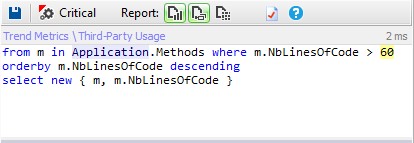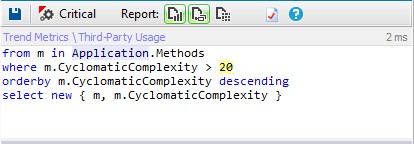The Microsoft Foundation Class Library is an application framework for programming in Microsoft Windows. Written in C++, MFC provides much of the code necessary for managing windows, menus, and dialog boxes; performing basic input/output; storing collections of data objects; and so on.
The MFC framework is a powerful approach but using it impacts the design of the application, it’s very intrusive and we have to be careful of how we use it.
Let’s analyze MFC8 with CppDepend to discover its code quality and design.
With CppDepend we analyze the quality of implementation and also the design of MFC.
A quality of implementation is important for developer who debug inside MFC,indeed not all things work as we like and sometimes we have to look inside the library code so if it’s not well implemented it complicate the task when debugging.
A design of MFC is very important for developers because it impact the design of the application because it’s very intrusive.
MFC General Information’s

The dependency Graph shows that MFC uses 149 methods from ATL and 1014 from Windows API, and there’s general Information’s about MFC:

Code Implementation
Naming Rules
Let’s execute the following CQLinq request:
WARN IF Count > 0 IN SELECT FIELDS WHERE !NameLike “^m_” AND !IsGlobal
The blue squares represent the result of the query, so almost 50% fields don’t begin with m_”.

And what about methods naming:
WARN IF Count > 0 IN SELECT METHODS WHERE !NameLike “^[A-Z]” AND !(IsClassConstructor OR IsConstructor) AND !IsInTierProject AND !IsGlobal AND !NameLike “^~” AND !NameLike “^operator”

There are just some few methods that not begin with Upper case.
Cyclomatic Complexity
Cyclomatic complexity is a popular procedural software metric equal to the number of decisions that can be taken in a procedure.
We can also consider that a method is complex if NbLinesOfCode,NbParameters or NbBariables are great than a defined values.
SELECT METHODS WHERE (NbLinesOfCode > 100 OR CyclomaticComplexity > 20 OR NbParameters > 5 OR NbVariables > 8 )

So 706 methods are candidates to refactoring, but the request can be changed, it’s depending on the choice of the complexity criteria for each team.
Comments
SELECT METHODS WHERE NbLinesOfComment > 0

Almost all classes are commented so developers can have an idea of what a method does particularly when debugging inside MFC.
Let’s see if all complex methods are commented.
SELECT METHODS WHERE (NbLinesOfCode > 100 OR CyclomaticComplexity > 20 OR NbParameters > 5 OR NbVariables > 8 ) AND NbLinesOfComment ==0

There are just few complex methods not commented.
DESIGN
No existence of namespaces
The namespace is an important concept to design application, it isolates functionalities under a module and provides a logical grouping, it can also make a library simple to use.
Unfortunately MFC don’t contain any namespace in spite of the existence of different functionality (GUI, OLE, Database, Containers …)
Global functions and variables
MFC contains 786 global functions and 338 global variables, its lot for an object oriented framework.
Inheritance
SELECT TYPES WHERE NbBaseClass >0

Almost all class has at least one base class, it cause a high coupling between classes.
Types Cohesion
The single responsibility principle states that a class should have more than one reason to change. Such a class is said to be cohesive. A high LCOM value generally pinpoints a poorly cohesive class. There are several LCOM metrics. The LCOM takes its values in the range [0-1]. The LCOMHS (HS stands for Henderson-Sellers) takes its values in the range [0-2]. Note that the LCOMHS metric is often considered as more efficient to detect non-cohesive types.
LCOMHS value higher than 1 should be considered alarming.
WARN IF Count > 0 IN SELECT TYPES WHERE LCOMHS > 0.95 AND NbFields > 10 AND NbMethods >10 AND !IsGlobal ORDER BY LCOMHS DESC

31 types from 529 are considered non cohesive.
Dependency between Classes
The option Direct & Indirect Weight of use the Dependency Structure Matrix is the perfect tool to let users know where the code structure is tangled with dependencies cycles.

The screenshot below shows that the 2 classes CDocument and CCmdUI are involved in a cycle of minimum length 5.

The whole dependency matrix shows that almost all MFC types are coupled directly or indirectly.

Coupling
The efferent coupling for a particular type is the number of types it directly depends on. Types with high efferent coupling are more complex than others,CppDepend propose a search panel, it’s like a wizard that help you construct query easily.
Let’s search for Types where efferent coupling is more than 30.

Doc/View Concept
MFC separates data management into these two classes. The document stores the data and manages printing the data and coordinates updating multiple views of the data. The view displays the data and manages user interaction with it, including selection and editing.
In dependency graph CDocument and CView are mutually dependent and usually the model don’t have to know the View and it must be independent of any external framework.

The model has to be as simple as possible with simple types and without any unnecessary coupling.
The following CQLinq request demonstrate that CDocument is highly coupled with GUI classes:
SELECT TYPES WHERE IsDirectlyUsedBy “CDocument“

The goal is to reuse the same model in different projects (Console, Gui, WebService, …) and if our model is the CDocument we can’t reuse easily in other projects.
Recommendation:Never use CDocument as model but use it just as controller to refresh views.
MFC Automation Server
CDocument can be used also as COM Component, but CDocument is coupled with CView and using CDocument as COM component can occur some unexpected limitations and problems.
When we instantiate a CDocument as COM Component a handle of view is created due to the coupling Doc/View so the number of instances to create is limited by the number of window handles that can be created, and the problem occur particularly if the instances are created in a no desktop session, in this case the number of handle that can be created is very limited by default.
Recommendation:
Avoid using CDocument as COM component, keep it simple and use ATL instead it’s more simple and flexible.

























































